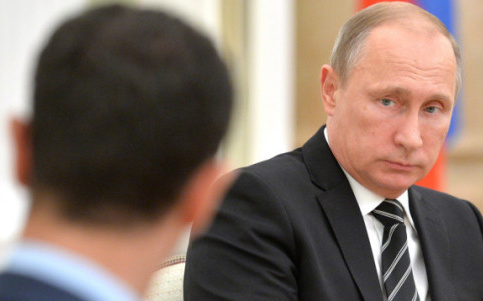Russian President Vladimir Putin with Syria’s Bashar al-Assad, Moscow, November 2015
On December 19, five days after a two-hour meeting with Turkish President Recep Tayyip Erdoğan, Donald Trump announced the withdrawal of US troops from Syria. But the order divided the Administration, with the resignations of Defense Secretary Jim Mattis and the US envoy to the anti-ISIS coalition, Brett McGurk, as well as pushback from National Security Advisor John Bolton. Erdoğan continues to warn of military operations against Kurdish territory in northern Syria if agreement is not reached over the US departure.
Since Trump’s command, the situation has changed little on the ground. US forces are still present. There have been no preparations for a possible withdrawal, apart from a token removal of some equipment. The US-led coaliton conducted 469 air and artillery strikes in Syria between 16 and 29 December, more than double the number of strikes carried out in the previous two weeks. The Islamic State has not disappeared — instead it carried out the deadliest attack on Americans in Syria’s 94-month conflict, with four US personnel among 16 people killed by a suicide bombing in Manbij in western Aleppo Province on January 16, and followed that with a car bomb targeting American and US-supported forces five days later.
Syria Daily, Jan 17: 4 Americans Among 16 Killed by ISIS Bomb
So what is the fate of Syria in 2019? Will the US position — should it stay, or should it go — be part of the reunification of the country? Or are we in a limbo of partition for the foreseeable future?
Whatever the outcome, the man overseeing the outcome is not in Washington. Or Damascus.
A New Strategic Environment
Syrian President Bashar al-Assad, Russia, and Iran have begun to exploit the new strategic environment created by a possible US withdrawal. At the end of December, Russia, Iran, and the Assad regime mobilized additional military units in the Euphrates Valley in Deir ez-Zor Province in eastern Syria. These reinforcements, including elite units of the Syrian Arab Army as well as elements of the Russian armed forces, are stationed to cross the river and seize the oil-rich areas currently controlled by the US-supported, Kurdish-led Syrian Democratic Forces.
Russia and Assad have also deployed reinforcements to block Turkey’s impending offensive against the SDF in Manbij. On January 8, Russian military police began patrols near the city, posting a video. The message — the US-led coalition is gone and Moscow is now in command, even if coalition forces are still operating in Manbij.
The Russo-Iranian coalition is likely to dissuade the Turkish President from gaining further ground while preparing for political reconciliation between the SDF and Damascus. Negotiations between the Kurdish autonomous government and the Assad regime are no longer a secret and “operational” agreements have been found on topics such as the exploitation of oil wells in the Kurdish control zone and on the presence of Syrian security forces in the city of Hasakah.
SDF commanders have recently acknowledged that they cannot withstand the combined pressures of Russia, Iran, the Assad regime, and Turkey without the support of the US coalition. So the Kurdish factions have reopened talks — albeit from a weaker position — for a diplomatic solution with the Assad regime. Kurdish leaders have also called for regime deployments to secure the Syrian-Turkish border, countering Erdoğan’s intention for a 32 km (20 mile) deep “safe zone” along the frontier. The final outcome of the negotiations will likely include the transfer of vast areas of northern and eastern Syria to regime forces, the first step towards a reunification of the country outside opposition-held territory in the northwest.
At the same time, concerns over border security have brought Iraq closer to the Russo-Iranian coalition. Iraqi Prime Minister Adel Abdul-Mehdi sent a high-ranking delegation to Damascus on December 30, led by National Security Advisor Falih al-Fayyadh. Afterwards, the Assad regime cleared Iraq to conduct unilateral airstrikes against the Islamic State inside Syria. Russia and Iran are likely to attempt to encourage these closer ties as another means of increasing their influence over the Iraqi government and to develop a capacity for regional power projection at the expense of the United States in the Middle East.
Putin as Power Broker
2019 may see an end to the territorial fragmentation of Syria. The slow withdrawal of the US, now set to take four to six months and to be coordinated with members of the coalition, will be paralleled by the expanding role of Russia and Iran — especially with Kurdish factions.
This will reinforce the hegemony of Moscow and Tehran in Syria, as Bashar al-Assad returns to the regional political scene. Russia, whose main objective in its military intervention has been to restore the Assad regime, will appear to other regional states as the only reliable partner in the Middle East. The Kremlin will replace the White House as a leader.
The only thing which might disrupt this scenario? An escalation of conflict between Israel and Iran, through its proxies, on Syrian territory. But even here, the power broker will be Vladimir Putin.


is that the end of the article?
Matt,
Apologies. A coding error cut off the rest of the article. Thanks for pointing this out.
S.